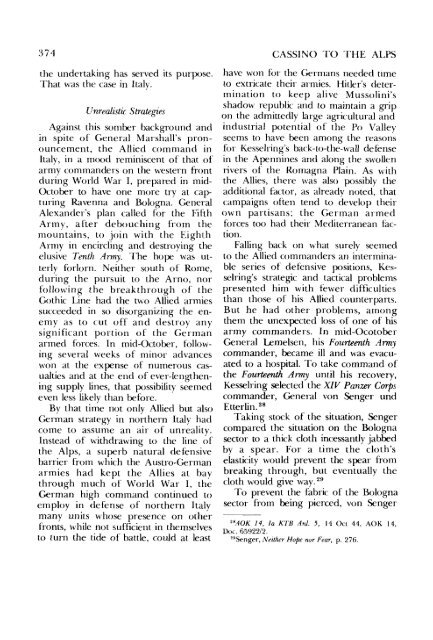Cassino to the Alps - US Army Center Of Military History
Cassino to the Alps - US Army Center Of Military History
Cassino to the Alps - US Army Center Of Military History
You also want an ePaper? Increase the reach of your titles
YUMPU automatically turns print PDFs into web optimized ePapers that Google loves.
374<br />
<strong>the</strong> undertaking has served its purpose.<br />
That was <strong>the</strong> case in Italy.<br />
Unrealistic Strategies<br />
Against this somber background and<br />
in spite of General Marshall's pronouncement,<br />
<strong>the</strong> Allied command in<br />
Italy, in a mood reminiscent of that of<br />
army commanders on <strong>the</strong> western front<br />
during World War I, prepared in mid<br />
Oc<strong>to</strong>ber <strong>to</strong> have one more try at capturing<br />
Ravenna and Bologna. General<br />
Alexander's plan called for <strong>the</strong> Fifth<br />
<strong>Army</strong>, after debouching from <strong>the</strong><br />
mountains, <strong>to</strong> join with <strong>the</strong> Eighth<br />
<strong>Army</strong> in encircling and destroying <strong>the</strong><br />
elusive Tenth <strong>Army</strong>. The hope was utterly<br />
fi:>rlorn. Nei<strong>the</strong>r south of Rome,<br />
during <strong>the</strong> pursuit <strong>to</strong> <strong>the</strong> Arno, nor<br />
following <strong>the</strong> breakthrough of <strong>the</strong><br />
Gothic Line had <strong>the</strong> t\",O Allied armies<br />
succeeded in so disorganizing <strong>the</strong> enemy<br />
as <strong>to</strong> cut off and destroy any<br />
significant portion of <strong>the</strong> German<br />
armed forces. In mid-Oc<strong>to</strong>ber, f()llowing<br />
several weeks of minor advances<br />
won at <strong>the</strong> expense of numerous casualties<br />
and at <strong>the</strong> end of ever-leng<strong>the</strong>ning<br />
supply lines, that possibility seemed<br />
even less likely than before.<br />
By that time not only Allied but also<br />
C..erman strategy in nor<strong>the</strong>rn Italy had<br />
come <strong>to</strong> assume an air of unreality.<br />
Instead of \vithdrawing <strong>to</strong> <strong>the</strong> line of<br />
<strong>the</strong> <strong>Alps</strong>, a superb natural defensive<br />
barrier from which <strong>the</strong> Austro-German<br />
armies had kept <strong>the</strong> Allies at bay<br />
through much of World War I, <strong>the</strong><br />
German high command continued <strong>to</strong><br />
employ in defense of nor<strong>the</strong>rn Italy<br />
many units whose presence on o<strong>the</strong>r<br />
fronts, while not sufficient in <strong>the</strong>mselves<br />
<strong>to</strong> turn <strong>the</strong> tide of battle, could at least<br />
CASSINO TO THE ALPS<br />
have won for <strong>the</strong> Germans needed tnne<br />
<strong>to</strong> extricate <strong>the</strong>ir armies. Hitler's determination<br />
<strong>to</strong> keep alive Mussolini's<br />
shadow republic and <strong>to</strong> maintain a grip<br />
on <strong>the</strong> admittedly large agricultural and<br />
industrial potential of <strong>the</strong> Po Valley<br />
seems <strong>to</strong> have been among <strong>the</strong> reasons<br />
for Kesselring's back-<strong>to</strong>-<strong>the</strong>-waU defense<br />
in <strong>the</strong> Apennines and along <strong>the</strong> swollen<br />
rivers of <strong>the</strong> Romagna Plain. As with<br />
<strong>the</strong> Allies, <strong>the</strong>re was also possibly <strong>the</strong><br />
additional fac<strong>to</strong>r, as already noted, that<br />
campaigns often tend <strong>to</strong> develop <strong>the</strong>ir<br />
own partisans; <strong>the</strong> German armed<br />
forces <strong>to</strong>o had <strong>the</strong>ir Mediterranean taction.<br />
Falling back on what surely seemed<br />
<strong>to</strong> <strong>the</strong> Allied commanders an interminable<br />
series of defensive positions, Kesselring's<br />
strategic and tactical problems<br />
presented him with fewer difficulties<br />
than those of his Allied counterparts.<br />
But he had o<strong>the</strong>r problems, among<br />
<strong>the</strong>m <strong>the</strong> unexpected loss of one of his<br />
army commanders. In mid-Oco<strong>to</strong>ber<br />
General Lemelsen, his Fourteenth <strong>Army</strong><br />
commander, became ill and was evacuated<br />
<strong>to</strong> a hospital. To take command of<br />
<strong>the</strong> Fourteenth <strong>Army</strong> until his recovery,<br />
Kesselring selected <strong>the</strong> XIV Panzer Corps<br />
commander, General von Senger und<br />
Etterlin. 28<br />
Taking s<strong>to</strong>ck of <strong>the</strong> situation, Senger<br />
compared <strong>the</strong> situation on <strong>the</strong> Bologna<br />
sec<strong>to</strong>r <strong>to</strong> a thick doth incessantly jabbed<br />
by a spear. For a time <strong>the</strong> cloth's<br />
elasticity would prevent <strong>the</strong> spear from<br />
breaking through, but eventually <strong>the</strong><br />
doth would give way.29<br />
To prevent <strong>the</strong> fabric of <strong>the</strong> Bologna<br />
sec<strong>to</strong>r from being pierced, von Senger<br />
28AOK 14, fa KTB Ani. 5, 14 Oct 44. AOK 14,<br />
Doc. 65922/2.<br />
29Senger, Nei<strong>the</strong>r Hope nor Fear, p. 276.
















